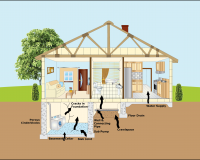Blogs from the Indoor Environments Program
 Leveraging Federal Relief Funds to Create Healthier Schools
Leveraging Federal Relief Funds to Create Healthier Schools
Published: June 9, 2021
Congress has appropriated $190 billion to assist school reopening efforts; the recent American Rescue Plan Act alone provides around $122 billion for PK-12 public education. The substantial federal infusion of relief funding is an important opportunity to improve IAQ and other school building conditions, but it is only a start.
 Now Is the Time to Address the Hidden Health Risks of Home Cooking
Now Is the Time to Address the Hidden Health Risks of Home Cooking
Published: May 17, 2021
The coronavirus pandemic has focused increased attention on indoor air quality and ventilation. Yet, many people remain unaware of the health risks posed by an activity that occurs every day in their homes: cooking.
 Recent Policies Target PFAS Substances in Food Packaging
Recent Policies Target PFAS Substances in Food Packaging
Published: March 15, 2021
Per- and polyfluoroalkyl substances, a class of toxic synthetic chemicals collectively known as PFAS, are all around us—in the environment and in our bodies. According to the Agency for Toxic Substances and Disease Registry, most people in the United States have PFAS in their blood. Scientific studies have shown that exposure to these “forever chemicals” can lead to a variety of adverse health effects, including increased cholesterol, pregnancy complications, and kidney and testicular cancers; recent studies also suggest that PFAS may reduce resistance to infectious diseases such as COVID-19 and may reduce antibody responses to vaccines.
 Improving Indoor Air Quality in Schools During the Pandemic . . . and Beyond
Improving Indoor Air Quality in Schools During the Pandemic . . . and Beyond
Published: October 22, 2020
The novel coronavirus has focused public attention on the indoor environment as never before. Even though most people in the United States spent the large majority of their time indoors before the pandemic, COVID-19 has increased awareness of the connection between indoor air quality and health. In addition to cleaning and disinfecting, technical topics such as building ventilation and filtration are now the subject of articles in popular media, not to mention conversations around the (virtual) water cooler and the school listserv.
 Addressing the Hazards of Particle Pollution Where Most Exposures Take Place—Indoors
Addressing the Hazards of Particle Pollution Where Most Exposures Take Place—Indoors
Published: February 19, 2020
Last month, new regulations took effect in California to address one of the most serious public health risks in the United States and around the world—particle pollution. The new regulations do not address vehicles, power plants, or other sources of pollution. Instead, they aim to reduce exposure to particle pollution where it occurs most—inside buildings. Particles in outdoor air enter buildings through cracks and gaps in the building and through natural or mechanical ventilation.
 States Craft New Policies for Protecting Indoor Air Quality
States Craft New Policies for Protecting Indoor Air Quality
Published: June 27, 2018
June is National Healthy Homes Month, a good time for policymakers to consider strategies for reducing exposure to air pollutants inside homes. It’s also a good time to highlight new policies in California and New York that aim to improve home indoor air quality and that are likely to have impacts beyond those two states.
 State Policies Are Still Needed to Reduce Radon Risk
State Policies Are Still Needed to Reduce Radon Risk
Published: January 17, 2018
January is National Radon Action Month, a good time for policymakers to consider what action they can take to address one of the most important—and preventable—indoor health risks facing their constituents. Radon is responsible for around 21,000 lung cancer deaths in the United States each year. That makes it the second leading cause of lung cancer overall and the leading cause among non-smokers, according to EPA.
 Climate Change: An Inside Story
Climate Change: An Inside Story
Published: April 26, 2017
Communities throughout the United States are experiencing a variety of conditions associated with a changing climate—hotter summers and heat waves, droughts, intense storms and flooding, increased average precipitation and humidity, and more severe wildfires. Alongside potentially far-reaching environmental and economic impacts, these conditions have direct and indirect effects on human health. In recent years, scientists have begun to shed light on important climate-related health effects that occur indoors, where people spend the vast majority of their time.